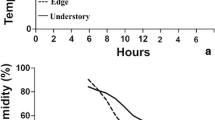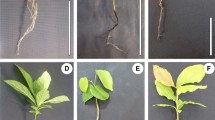Abstract
Levels of phenolic secondary metabolites in the leaves of four west African rain-forest plants,Acacia pennata, Cynometra leonensis, Diopyros thomasii, andTrema guineensis, were correlated with incident light intensity at both the inter- and intraindividual level. Enhanced phenolic levels under high light intensity appeared to be due to production of both polyphenolics (condensed and hydrolyzable tannins) and simple phenolics. InTrema guineensis, where it is possible to separate leaves in terms of both their age and the light incident upon them, condensed tannin production progressed differently during the development of “sun” and “shade” leaves, suggesting continuing production of new oligomers in the former but not in the latter. The results of this study suggest that the production of phenolics in relation to variation in incident light is a finely tuned process, which must be explained in terms of plant physiology and intermediate metabolism rather than in terms of resource allocation or a direct response to herbivory.
Similar content being viewed by others
References
Ayres, P.G. 1984. The interaction between environmental stress injury and biotic disease physiology.Annu. Rev. Phytopathol. 22:53–75
Balwdin, I.T., andSchultz, J.C. 1983. Rapid changes in tree leaf chemistry induced by damage: Evidence for communication between plants.Science 221:277–279.
Barry, T. N., andForss, D.A. 1983. The condensed tannin content ofLotus pedunculatus, its regulation by fertiliser application and effect on protein solubility.J. Sci. Food Agric. 34:1047–1056.
Bell, E.A. 1978. Toxins in seeds, pp. 143–162,in J.B. Harborne (ed.). Biochemical Aspects of Plant and Animal Co-evolution. Academic Press, London.
Berenbaum, M.R. 1983. Effect of tannins on growth and digestion in two species of papilionids.Entmol. Exp. Appl. 34:245–250.
Bernays, E.A. 1978. Tannins: An alternative viewpoint.Entomol. Exp. Appl. 24:244–253.
Bryant, J.P. 1987. Resource availability: Implications for constitutive and long-term inducible defenses in foliage of woody plants,in Chemical Ecology. American Institute of Biological Sciences. In press.
Bryant, J.P., Chapin, F.S., III, andKlein, D.R. 1983. Carbon/nutrient balance of boreal plants in relation to vertebrate herbivory.Oikos 40:357–368.
Burns, R.E. 1971. Method for estimation of tannin in grainSorghum.Agron. J. 63:511–512.
Butler, L.G. 1982. Polyphenols and their effects on Sorghum grain quality, pp. 294–311,in Proceedings of the International Symposium on Sorghum Grain Quality. ICRISAT (International Crops Research Institute for the Semi-Arid Tropics). Patancheru, A. P., India.
Butler, L.G., Price, M.L., andBrotherton, J.E. 1982. Vanillin assay for proanthocyanidins (condensed tannins): Modification of the solvent for estimation of the degree of polymerisation.J. Agric. Food Chem. 30:1087–1089.
Camm, E.L., andTowers, G.H.N. 1973. Phenylalanine ammonia lyase.Phytochemistry 12:961–973.
Campbell, R.C. 1974. Statistics for Biologists, Cambridge University Press, Cambridge.
Chesters, C.G.C., andRobinson, G.N. 1951. Zinc in the metabolism of a strain ofAspergillus niger.J. Gen. Microbiol. 5:553–558.
Cole, N.H.A. 1968. The Vegetation of Sierra Leone. Njala University College Press, Sierra Leone.
Coley, P.D., Bryant, J.P., andChapin, F.S., III. 1985. Resource availability and plant anti-herbivore defenses.Science 230:895–899.
Feeny, P.P. 1970. Seasonal changes in oak leaf tannins and nutrients as a cause of spring feeding by wintermoth caterpillars.Ecology 51:565–581.
Feeny, P.P. 1976. Plant apparency and chemical defence.Recent Adv. Phytochem. 10:1–40.
Fraenkel, G.S. 1959. The raison d'etre of plant secondary substances.Science 129:1466–1470.
Gartlan, S.J., McKey, D.B., Waterman, P.G., Mbi, C.N., andStruhsaker, T.T. 1980. A comparative study of the phytochemistry of two African rain-forests.Biochem. Syst. Ecol. 8:401–422.
Goldstein, J.L., andSwain, T. 1963. Changes in tannins in ripening fruits.Phytochemistry 2:371–383.
Hanley, T.A., Gates, R.G., Horne, V., andMcKendrick, J.D. 1986. Forest stand age-related differences in apparent nutritional quality for deer in southeastern Alaska,in F.D. Provenza and F.D. Flinders (eds.). Proceedings of the 4th Annual Wildland Shrub Symposium. Brigham Young Univ. Press, Provo, Utah. In press.
Hanson, K.R., andHavir, E.A. 1981. Phenylalanine ammonia lyase, pp. 577–626,in E.E. Conn (ed.). The Biochemistry of Plants: A Comprehensive Treatise. Academic Press, New York.
Harborne, J.B. 1985. Phenolics and plant defence, pp. 393–408,in C.F. van Sumere and P.J. Lea (eds.). The Biochemistry of Plant Phenolics. Clarendon Press, Oxford.
Haslam, E. 1977. Symmetry and promiscuity in procyanidin biochemistry.Phytochemistry 16:1625–1640.
Haslam, E. 1985. Metabolites and Metabolism. Clarendon Press, Oxford.
Hillis, W.E., andSwain, T. 1959. Phenolic contents ofPrunus domestica II. The analysis of the tissus of the victoria plum tree.J. Sci. Food Agric. 10:135–144.
Hoffman, P. 1986. Ecophysiological aspects of biomass production in higher plants.Photosynthesis Res. 7:3–18.
Hutchinson, J., andDalziel, J.M. 1958. Flora of West Tropical Africa, 2nd. ed. Crown Agents, London.
Janzen, D.H. 1972. Protection ofBarteria fistulosa byPachyssima ants (Pseudomyrmecinae) in a Nigerian rainforest.Ecology 53:885–892.
Janzen, D.H. 1974. Tropical blackwater rivers, animals and mast fruiting by the Dipterocarpaceae.Biotropica 6:69–103.
Larsson, S., Wiren, A., Ericsson, T., andLundgren, L. 1986. Effects of light and nutrient stress on defensive chemistry and susceptibility toGalerucella lineola (Coleoptera, Chrysomelidae) in twoSalix species.Oikos 47:205–210.
Margna, U. 1977. Control of the level of substrate supply; an alternative in the regulation of phenyl propanoid accumulation in plant cells.Phytochemistry 16:419–426.
Martin, M.M., andMartin, J.S. 1984. Surfactants: their role in preventing the precipitation of proteins by tannins in insect guts.Oecologia 62:342–345.
McClure, J.W. 1985. Physiology of flavonoids in plants, pp. 77–85,in V. Cody, E. Middleton, and J.B. Harborne (eds). Plant Flavonoids in Biology and Medicine. Alan R. Liss, New York.
McKey, D.B. 1979. The distribution of secondary compounds within plants, pp. 56–134,in G.A. Rosenthal and D.H. Janzen (eds.). Herbivores: Their Interaction with Secondary Plant Metabolites. Academic Press, New York.
Mehansho, H., Clements, S., Sheares, B.T., Smith, S., andCarlson, D.M. 1985. Induction of proline-rich glycoprotein synthesis in mouse salivary glands by isoproterenol and by tannins.J. Biol. Chem. 260:4418–4423.
Mole, S. 1986. Tannins: A biochemical re-analysis of their importance as anti-feedants. PhD thesis, University of Strathclyde, Glasgow, Scotland.
Mole, S., andWaterman, P.G. 1985. Stimulatory effects of tannins and cholic acid on tryptic hydrolysis of proteins: Ecological implications.J. Chem. Ecol. 11:1323–1332.
Mole, S., andWaterman, P.G. 1986. Tannins as anti-feedants to mammalian herbivores: Still an open question?, pp. 572–587,in G.R. Waller (ed). Allelochemicals, Their Role in Forestry, Agriculture and Ecology. American Chemical Society, Washington, D.C.
Northcote, D.H. 1985. Control of cell wall formation during growth, pp. 177–197,in C.T. Brett and J.R. Hillman (eds). Biochemistry of Plant Cell Walls. Cambridge University Press, London.
Pierpoint, W.S. 1985. Phenolics in food and feedstuffs: The pleasures and perils of vegetarianism, pp. 427–451,in C.F. Van Sumere and P.J. (eds.). The Biochemistry of Plant Phenolics. Clarendon Press, Oxford.
Rajaratnam, J.A., andHock, L.J. 1975. Effect of boron nutrition on intensity of red spider mite attack on oil palm seedlings.Exp. Agric. 11:59–63.
Rhoades, D.F. 1979. Evolution of plant chemical defence against herbivores, pp. 4–55,in G.A. Rosenthal and D.H. Janzen (eds.). Herbivores: Their Interaction with Secondary Plant Metabolites. Academic Press, New York.
Rhoades, D.F., andCates, R.G. 1976. Towards a general theory of plant antiherbivore chemistry.Recent Adv. Phytochem. 10:168–213.
Savil, P.S., andFox, J.E.D. 1966. Trees of Sierra Leone. Forestry Department, Freetown, Sierra Leone.
Schultz, J.C. 1983. Impact of variable plant defence chemistry on susceptibility of insects to natural enemies, pp. 37–54,in P.A. Hedin (ed). Plant Resistance to Insects. American Chemical Society, Washington, D.C.
Treichel, S., Brinckmann, E., Scheitler, B., andVon Willert, D.J. 1984. Occurrence and changes of proline content in plants in the southern Namib Desert in relation to increasing and decreasing drought.Planta 162:236–242.
Waring, R.H., Mcdonald, A.J.S., Larsson, S., Ericsson, T., Wiren, A., Arwidsson, E., Ericsson, A., andLohammar, T. 1985. Differences in chemical composition of plants grown in constant relative growth rates with stable mineral nutrition.Oecologia 65:157–160.
Waterman, P.G. 1983. Distribution of secondary metabolites: Toward an understanding of cause and effect, pp. 167–179,in S.L. Sutton, T.C. Whitmore, and A.C. Chadwick (eds.). Tropical Rainforest: Ecology and Management. Blackwell Scientific, Oxford.
Waterman, P.G., Ross, J.A.M., andMcKey, D.B. 1984. Factors affecting levels of some phenolic compounds, of digestibility, and nitrogen content of the mature leaves ofBarteria fistulosa (Passifloraceae).J. Chem. Ecol. 10:387–401.
Wilson, C.M. 1955. The effect of soil treatments on the tannin content ofLespedeza sericea.Agron. J. 47:83–86.
Woodhead, S. 1981. Environmental and biotic factors affecting the phenolic content of different cultivars ofSorghum bicolor.J. Chem. Ecol. 7:1035–1047.
Zucker, W.V. 1983. Tannins: Does structure determine function? An ecological perspective.Am. Nat. 121:335–365.
Author information
Authors and Affiliations
Rights and permissions
About this article
Cite this article
Mole, S., Ross, J.A.M. & Waterman, P.G. Light-induced variation in phenolic levels in foliage of rain-forest plants. J Chem Ecol 14, 1–21 (1988). https://doi.org/10.1007/BF01022527
Received:
Accepted:
Issue Date:
DOI: https://doi.org/10.1007/BF01022527




